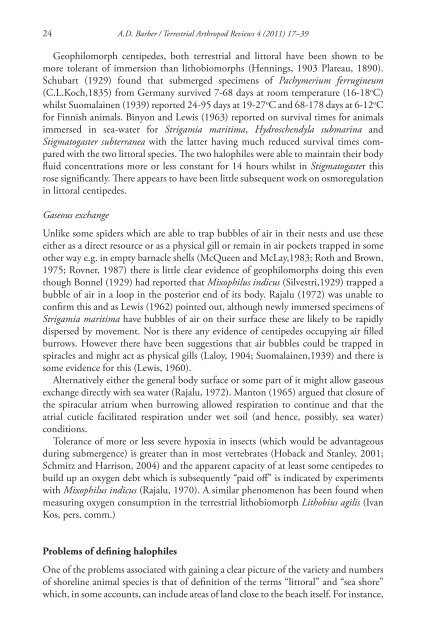Geophilomorph centipedes and the littoral habitat - Books and ...
Geophilomorph centipedes and the littoral habitat - Books and ...
Geophilomorph centipedes and the littoral habitat - Books and ...
You also want an ePaper? Increase the reach of your titles
YUMPU automatically turns print PDFs into web optimized ePapers that Google loves.
24 A.D. Barber / Terrestrial Arthropod Reviews 4 (2011) 17–39<br />
<strong>Geophilomorph</strong> <strong>centipedes</strong>, both terrestrial <strong>and</strong> <strong>littoral</strong> have been shown to be<br />
more tolerant of immersion than lithobiomorphs (Hennings, 1903 Plateau, 1890 ).<br />
Schubart ( 1929 ) found that submerged specimens of Pachymerium ferrugineum<br />
(C.L.Koch,1835) from Germany survived 7-68 days at room temperature (16-18 o C)<br />
whilst Suomalainen ( 1939 ) reported 24-95 days at 19-27 o C <strong>and</strong> 68-178 days at 6-12 o C<br />
for Finnish animals. Binyon <strong>and</strong> Lewis ( 1963 ) reported on survival times for animals<br />
immersed in sea-water for Strigamia maritima , Hydroschendyla submarina<br />
Stigmatogaster subterranea with <strong>the</strong> latter having much reduced survival times compared<br />
with <strong>the</strong> two <strong>littoral</strong> species. Th e two halophiles were able to maintain <strong>the</strong>ir body<br />
fl uid concentrations more or less constant for 14 hours whilst in Stigmatogaste r this<br />
rose signifi cantly. Th ere appears to have been little subsequent work on osmoregulation<br />
in <strong>littoral</strong> <strong>centipedes</strong>.<br />
Gaseous exchange<br />
Unlike some spiders which are able to trap bubbles of air in <strong>the</strong>ir nests <strong>and</strong> use <strong>the</strong>se<br />
ei<strong>the</strong>r as a direct resource or as a physical gill or remain in air pockets trapped in some<br />
o<strong>the</strong>r way e.g. in empty barnacle shells (McQueen <strong>and</strong> McLay, 1983 ; Roth <strong>and</strong> Brown,<br />
1975 ; Rovner, 1987 ) <strong>the</strong>re is little clear evidence of geophilomorphs doing this even<br />
though Bonnel ( 1929 ) had reported that Mixophilus indicus (Silvestri, 1929 ) trapped a<br />
bubble of air in a loop in <strong>the</strong> posterior end of its body. Rajalu ( 1972 ) was unable to<br />
confi rm this <strong>and</strong> as Lewis ( 1962 ) pointed out, although newly immersed specimens of<br />
Strigamia maritima have bubbles of air on <strong>the</strong>ir surface <strong>the</strong>se are likely to be rapidly<br />
dispersed by movement. Nor is <strong>the</strong>re any evidence of <strong>centipedes</strong> occupying air fi lled<br />
burrows. However <strong>the</strong>re have been suggestions that air bubbles could be trapped in<br />
spiracles <strong>and</strong> might act as physical gills (Laloy, 1904 ; Suomalainen, 1939 ) <strong>and</strong> <strong>the</strong>re is<br />
some evidence for this (Lewis, 1960).<br />
Alternatively ei<strong>the</strong>r <strong>the</strong> general body surface or some part of it might allow gaseous<br />
exchange directly with sea water (Rajalu, 1972 ). Manton ( 1965 ) argued that closure of<br />
<strong>the</strong> spiracular atrium when burrowing allowed respiration to continue <strong>and</strong> that <strong>the</strong><br />
atrial cuticle facilitated respiration under wet soil (<strong>and</strong> hence, possibly, sea water)<br />
conditions.<br />
Tolerance of more or less severe hypoxia in insects (which would be advantageous<br />
during submergence) is greater than in most vertebrates (Hoback <strong>and</strong> Stanley, 2001 ;<br />
Schmitz <strong>and</strong> Harrison, 2004 ) <strong>and</strong> <strong>the</strong> apparent capacity of at least some <strong>centipedes</strong> to<br />
build up an oxygen debt which is subsequently “paid off ” is indicated by experiments<br />
with Mixophilus indicus (Rajalu, 1970 ). A similar phenomenon has been found when<br />
measuring oxygen consumption in <strong>the</strong> terrestrial lithobiomorph Lithobius agilis (Ivan<br />
Kos, pers. comm.)<br />
Problems of defi ning halophiles<br />
One of <strong>the</strong> problems associated with gaining a clear picture of <strong>the</strong> variety <strong>and</strong> numbers<br />
of shoreline animal species is that of defi nition of <strong>the</strong> terms “<strong>littoral</strong>” <strong>and</strong> “sea shore”<br />
which, in some accounts, can include areas of l<strong>and</strong> close to <strong>the</strong> beach itself. For instance,<br />
<strong>and</strong>









![Am HaSefer [Volk des Buches] - Books and Journals](https://img.yumpu.com/20648352/1/174x260/am-hasefer-volk-des-buches-books-and-journals.jpg?quality=85)







